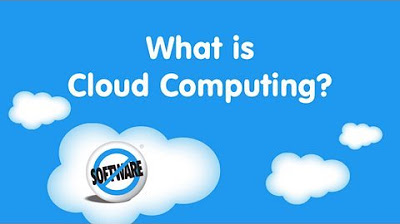Cloud computing
Summary
TLDRCloud computing, as defined by the U.S National Institute of Standards and Technology, is an IT usage model characterized by on-demand self-service, broad network access, resource pooling, elasticity, and pay-as-you-go pricing. This technology allows customers to access computing resources like processing power and storage over the internet, without the need for human intervention. The video script introduces the concept of IT infrastructure, comparing it to a city's infrastructure, and outlines the exploration of Google Cloud's infrastructure services, aiming to familiarize viewers with their functionalities and potential applications.
Takeaways
- 🌐 **Cloud Computing Defined**: Cloud computing is a model for delivering information technology services where resources are retrieved over the internet.
- 🔑 **On-Demand Self-Service**: Users can access computing resources on-demand without requiring human interaction, much like using a web interface.
- 🌍 **Wide Network Access**: Resources are available over the internet, allowing access from any location with a connection.
- 💧 **Resource Pooling**: Providers maintain a large pool of resources to serve multiple users, which enables cost-effective bulk purchasing and savings passed on to customers.
- 📍 **Location Independence**: Users are not concerned with the physical location of the provided resources, enhancing flexibility.
- 🔄 **Elasticity**: Resources can be rapidly and elastically increased or decreased based on demand, allowing for scalability and cost efficiency.
- 💸 **Pay-as-you-go**: Customers are billed based on actual usage or reserved capacity, aligning costs with utilization.
- 🏗️ **IT Infrastructure Analogy**: IT infrastructure can be likened to a city's infrastructure, with users, applications, and services supported by underlying systems.
- 🚀 **Google Cloud Services**: The course will cover IT infrastructure services provided by Google Cloud, helping learners understand their functionalities.
- 🎓 **Learning Outcomes**: Participants will gain familiarity with Google Cloud's infrastructure services and begin to grasp their practical applications.
Q & A
What is the origin of the term 'cloud computing'?
-The term 'cloud computing' was created by the U.S National Institute of Standards and Technology.
What are the five key traits of cloud computing?
-The five key traits of cloud computing are on-demand self-service, broad network access, resource pooling, elasticity, and measured service.
How does on-demand self-service in cloud computing benefit users?
-On-demand self-service allows users to obtain processing power, storage, and network resources without human intervention through a web interface.
What does it mean for cloud computing resources to have 'broad network access'?
-Broad network access means that users can access computing resources over the internet from anywhere they have a connection.
How does resource pooling in cloud computing benefit the provider and the customers?
-Resource pooling allows the provider to have a large pool of resources, which they can allocate to users as needed. This enables the provider to buy in bulk and pass the savings onto the customers.
Why do customers not need to know the physical location of cloud computing resources?
-Customers don't need to know the exact physical location of resources because the cloud provider manages the infrastructure and ensures accessibility.
What is meant by the 'elasticity' of cloud computing resources?
-Elasticity refers to the ability of cloud computing resources to automatically increase or decrease as needed, allowing customers to scale up or down quickly.
How does the payment model in cloud computing differ from traditional IT services?
-In cloud computing, customers pay only for what they use or reserve as they go, unlike traditional IT services where they might pay for fixed resources regardless of usage.
What is the role of IT infrastructure in cloud computing?
-IT infrastructure in cloud computing is the underlying framework of facilities and systems that support the delivery of services, similar to how a city's infrastructure supports its functions.
How does the analogy of a city's infrastructure help in understanding IT infrastructure?
-In the analogy, people in the city represent users in IT, cars and bikes represent applications, and the services provided are like the applications running on the infrastructure.
What will be the focus of the course on IT infrastructure services provided by Google Cloud?
-The course will focus on exploring the IT infrastructure services offered by Google Cloud, helping participants understand what the services do and how to use them.
Outlines

Этот раздел доступен только подписчикам платных тарифов. Пожалуйста, перейдите на платный тариф для доступа.
Перейти на платный тарифMindmap

Этот раздел доступен только подписчикам платных тарифов. Пожалуйста, перейдите на платный тариф для доступа.
Перейти на платный тарифKeywords

Этот раздел доступен только подписчикам платных тарифов. Пожалуйста, перейдите на платный тариф для доступа.
Перейти на платный тарифHighlights

Этот раздел доступен только подписчикам платных тарифов. Пожалуйста, перейдите на платный тариф для доступа.
Перейти на платный тарифTranscripts

Этот раздел доступен только подписчикам платных тарифов. Пожалуйста, перейдите на платный тариф для доступа.
Перейти на платный тарифПосмотреть больше похожих видео
5.0 / 5 (0 votes)






